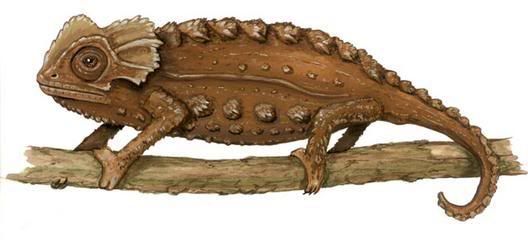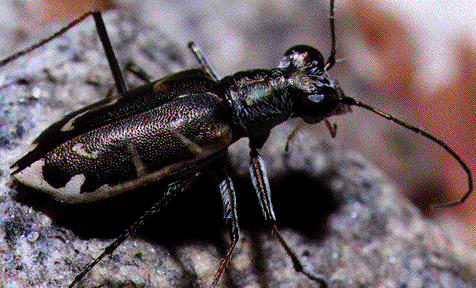 |
| Image from Animal Diversity Web |
This is the Astingy Leaf Chameleon (Brookesia perarmata2). The Brookesia genus contains the smallest chameleons, and in fact, some of the worlds smallest reptiles. One picture on this website shows one sitting comfortably on a gum wrapper with lots of room to spare. The Astingy Chameleon, also known as the Armored Chameleon, isn’t quite that small, growing to a whopping five inches.
Astingy Chameleons aren’t quite your typical chameleon. Sure, they’ve got the zygodactyly, the projectile tongue, and independent eye movement, but no color change, and no prehensile tail. Actually, most of the Brookesia genus is collectively known as the stump-tailed chameleons. As a forest floor-dwelling species, prehensile tails are pointless, and, when the idea is to look like a dead leaf, and one is this good at it, why bother to change colors? They enhance the leaf-mimicry by rocking in the wind, and, when frightened, falling to the ground, motionless.
Astingy Leaf Chameleons are named after their home, the Astingy region of Madagascar. Since Madagascar is hot and muggy all year round, there is no real mating season, though it is thought that it tends to occur in the rainier times of the year. Eggs are laid under the leaf litter, where the constant background level of decomposition nicely regulates the heat and moisture content of the nest.
When you first saw the picture, I’m sure you either thought it was hideous or you wanted to take it home. I’ll admit, I was one of the latter--that’s the problem. The pet trade3 has affected chameleon populations worldwide. Granted, the Armored Chameleon has this problem less than the more colorful ones, but it’s still enough that CITES has put it on their list. Deforestation, as the human impact on Madagascar rises, causes habitat to be lost for our spiky friend here.
1I’ve got to get around to e-mailing them to see if they’ll let me use their pictures here instead of just linking to them. They’ve got the strangest species, all on the IUCN redlist, which is exactly what I need.
2Mike, I’m liking the scientific name translations. Keep it up.
3Hm… this is the first EUT to have a problem with the pet trade. Does that make it cute? Nah.



